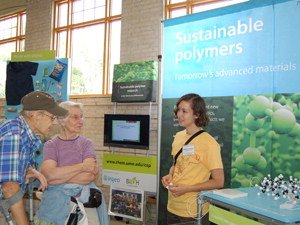Center for Sustainable Polymers gets major grant for research on environment-friendly plastics

Contacts:
Rhonda Zurn, College of Science and Engineering, rzurn@umn.edu, (612) 626-7959
Preston Smith, University News Services, smith@umn.edu, (612) 625-0552
MINNEAPOLIS / ST. PAUL (09/12/2011)-Research on creating more environment-friendly, cost-efficient plastics from natural and renewable materials got a boost today as the University of Minnesota announced a $1.5 million grant over three years from the National Science Foundation (NSF) Centers for Chemical Innovation program to the University's Center for Sustainable Polymers. The grant also makes the University eligible for additional funding in the future.
“We are tremendously excited about this new support from the NSF,” said Marc Hillmyer, director of the Center for Sustainable Polymers and a chemistry professor in the University's College of Science and Engineering. “With our strong history in polymer science and seed funding from the University of Minnesota, we have already been able to establish a national presence in the sustainable polymer arena."
The Center for Sustainable Polymers focuses its research on the challenge of creating advanced synthetic polymers (plastics) from renewable, natural, and sustainable resources instead of finite fossil fuels. Those resources include vegetable oils, starches, sugars, and terpenes (essential organic oils produced by plants, flowers, and conifers). Researchers are especially interested in materials that require low energy input, are non-toxic, and can be composted.
In addition to advancing cutting-edge polymer research at the University, the center focuses on forming partnerships with industries, teaching students about sustainable materials, and educating and engaging the public.
Hillmyer said this newly established Center for Chemical Innovation will help Minnesota become a leading global center of excellence in sustainable polymer science and greatly expand the center's capabilities.
“With Minnesota's leadership in the area of biobased materials and the University's breadth of expertise, we are well-positioned to make significant and important research contributions,” Hillmyer added.
About the center
The Center for Sustainable Polymers was launched in May 2009 as a research center within the University of Minnesota College of Science and Engineering. The center secured seed funding provided by the University's Initiative for Renewable Energy and the Environment (IREE) large grant program intended to help launch early-stage, high-potential projects in emerging fields of renewable energy and the environment.
Over the last two years, the Center for Sustainable Polymers has recruited 24 company affiliates with similar ambitions, including 3M, Cargill, Dow, H.B. Fuller and others.
“There is a tremendous amount of activity in the industrial sector in the area of biobased materials,” Hillmyer said. “The Center for Sustainable Polymers aims to partner with industry and provide the necessary fundamental research that underpins new and emerging sustainable polymer technologies.”
The center's collegiate partners are also engaged in a range of education and public outreach activities. For example, the Humphrey School of Public Affairs' Center for Science, Technology and Public Policy helps foster important initiatives aimed at educating the public and policy makers about the societal importance of creating sustainable technologies. The Center for Sustainable Polymers created an interactive exhibit for the 2010 and 2011 Eco Experience Building at the Minnesota State Fair aimed at educating the public-at-large about science, technology, and forefront sustainable polymer research. More than 300,000 people visited the exhibit each year.
In addition to the research and public outreach, the Center for Sustainable Polymers fosters broadening the participation of underrepresented minority students in relevant fields of science, technology, engineering, and math (STEM) by building partnerships with the University of Minnesota Office for Diversity Outreach, the North Star STEM Alliance, and the University of Minnesota Urban Research and Outreach/Engagement Center in north Minneapolis.
Over the next three years, the already-successful Center for Sustainable Polymers will work to achieve its new goals, which may make it eligible for even more funding. NSF Centers for Chemical Innovation program is a two-phase program. Successful centers receiving the three-year phase I funding are eligible for phase II grants that provide up to $40 million over 10 years.
For more information about the Center for Sustainable Polymers research activities, researchers, and University and industry partners, visit www.chem.umn.edu/csp.
